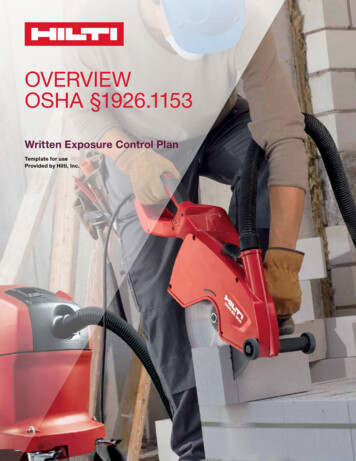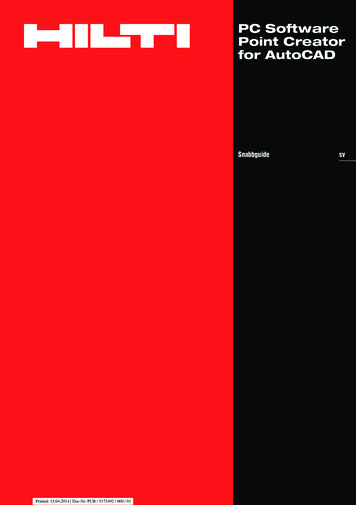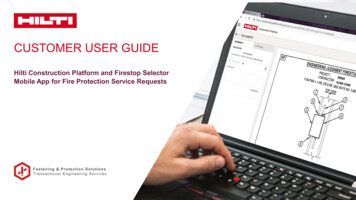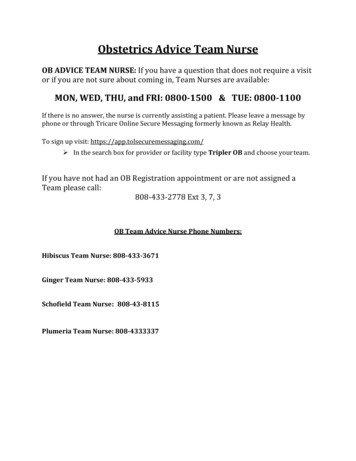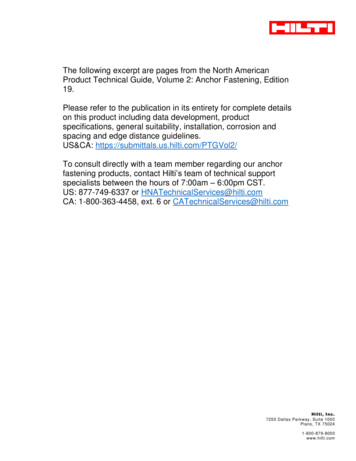
Transcription
The following excerpt are pages from the North AmericanProduct Technical Guide, Volume 2: Anchor Fastening, Edition19.Please refer to the publication in its entirety for complete detailson this product including data development, productspecifications, general suitability, installation, corrosion andspacing and edge distance guidelines.US&CA: https://submittals.us.hilti.com/PTGVol2/To consult directly with a team member regarding our anchorfastening products, contact Hilti’s team of technical supportspecialists between the hours of 7:00am – 6:00pm CST.US: 877-749-6337 or HNATechnicalServices@hilti.comCA: 1-800-363-4458, ext. 6 or CATechnicalServices@hilti.comHilti, Inc.7250 Dallas Parkway, Suite 1000Plano, TX 750241-800-879-8000www.hilti.com
3.2.2 HIT-HY 200 ADHESIVE ANCHORING SYSTEMPRODUCT DESCRIPTIONHIT-HY 200 with HIT-Z rods, Threaded Rod, Rebar, and HIS-N/RN InsertsAnchor SystemFeatures and Benefits Two great products with equal performance dataHilti HIT-HY 200-RCartridge User can select product gel time suitabilitybased on temperature of the base material andjobsite time requirements No hole cleaning requirement when installedSafeSet hollow drill bit technologyHilti HIT-HY 200-ACartridge No hole cleaning requirement when installingHIT-Z anchor rods in dry conditions withhammer drilled holes ICC-ES approved for cracked concrete andseismic serviceHilti HIT-Z AnchorRodHilti HASThreadedRod May be installed in diamond cored holes withHIT-Z anchor rod only when addition cleaningsteps are employed ICC-ES approved for grout-filled concretemasonryRebarHilti edconcrete masonrySeismic DesignDiamond coredCategories A-F holes for Crackedand UncrackedConcreteHollow Drill BitProfis Anchordesign softwareApprovals/ListingsICC-ES (International Code Council)NSF/ANSI Std 61European Technical ApprovalCity of Los AngelesFlorida Building CodeU.S. Green Building CouncilDepartment of Transportation40ESR-3187 in concrete per ACI 318-14 Ch. 17 / ACI 355.2/ ICC-ES AC308ESR-3963 in grout-filled CMU per ICC-ES AC58ELC-3187 in concrete per CSA A23.3-14 / ACI 355.2Certification for use in potable waterETA-11/0492, ETA-11/0493ETA-12/0006, ETA-12/0028ETA-12/0083, ETA-12/0084City of Los Angeles 2017 LABC Supplement (within ESR-3187 for Concrete)Research Report No. 26077 for Masonry2017 Florida Building Code Supplement (within ESR-3187)LEED Credit 4.1-Low Emitting MaterialsContact Hilti for various statesAnchor Fastening Technical Guide Edition 19 3.0 ANCHORING SYSTEMS 3.2.2 HILTI HIT-HY 200Hilti, Inc. (U.S.) 1-800-879-8000 en español 1-800-879-5000 www.hilti.com Hilti (Canada) Corporation www.hilti.com 1-800-363-4458
Anchor Fastening Technical Guide, Edition 19MATERIAL SPECIFICATIONSFor material specifications for anchor rods and inserts, please refer to section 3.2.8.DESIGN DATA IN CONCRETE PER ACI 318 ACI 318-14 Chapter 17 designThe load values contained in this section are Hilti Simplified Design Tables. The load tables in this section were developed usingthe Strength Design parameters and variables of ESR-3187 and the equations within ACI 318-14 Chapter 17. For a detailedexplanation of the Hilti Simplified Design Tables, refer to section 3.1.8. Data tables from ESR-3187 are not containedin this section, but can be found at www.icc-es.org or at www.hilti.com. HIT-HY 200 adhesive with HIT-Z and HIT-Z-R anchor teWater-saturatedconcretePermissible drillingmethodPermissibleconcrete conditionsFigure 1 - Hilti HIT-Z and HIT-Z-R installation conditionsHammer drilling with carbidetipped drill bit 1Hilti TE-CD or TE-YD HollowDrill Bit 2Diamond core drill bit 31 A nchor may be installed in a hole drilled with a carbide-tipped bit without cleaning the drilling dust from the hole. Temperature must be 41 F or higher.Drilling dust must be removed from the hole if the temperature is below 41 F. See Manufacturer’s Published Installation Instructions (MPII).2 When temperatures are below 41 F, TE-CD or TE-YD Hollow Drill Bits used with a Hilti vacuum cleaner are viable methods for removing drilling dust from the hole.3 Holes drilled by diamond coring require cleaning with a wire brush, a water hose and compressed air. See MPII.Figure 2 - Hilti HIT-Z and HIT-Z-RspecficationsTable 1 - Specifications for Hilti HIT-Z and HIT-Z-R installedwith Hilti HIT-HY 200 adhesiveSetting informationDiameterof fixture holeUnitsdoNominal anchor (114)(152)(190)(216)through-setin.1/25/813/161 15/161presetin.7/169/1611/16Nominal bit allation torquehef,minhef,maxTinstFigure 3 Installation with (2) washers13/16ft-lb153060110(Nm)(20)(40)(80)(150)1 Install using (2) washers. See Figure 3.Anchor Fastening Technical Guide Edition 19 3.0 ANCHORING SYSTEMS 3.2.2 HILTI HIT-HY 200Hilti, Inc. (U.S.) 1-800-879-8000 en español 1-800-879-5000 www.hilti.com Hilti (Canada) Corporation www.hilti.com 1-800-363-445841
Table 2 - Hilti HIT-Z and HIT-Z-R anchor rod length and thread dimensionℓAnchor lengthℓhelixHelix lengthSmooth shanklengthTotal threadlengthUsable -ZLengthCode3/8 x 3)D3/8 x 3)F3/8 x )H3/8 x 4)J1/2 x 2 x 7)J1/2 x 109)M5/8 x 66(152)3-5/8(92)7/16(11)1-15/16(49)1-1/8(28)I5/8 x ze5/8 x 9-1/23/4 x 6-1/26-1/2(165)4(102)5/16(8)2(51)1(26)K3/4 x 8-1/28-1/2(216)4(102)7/16(12)4(102)3-1/16(77)N3/4 x igure 4 - Hilti HIT-Z and HIT-Z-R anchor rod length and thread dimension42Anchor Fastening Technical Guide Edition 19 3.0 ANCHORING SYSTEMS 3.2.2 HILTI HIT-HY 200Hilti, Inc. (U.S.) 1-800-879-8000 en español 1-800-879-5000 www.hilti.com Hilti (Canada) Corporation www.hilti.com 1-800-363-4458
Anchor Fastening Technical Guide, Edition 19Table 3 - Hilti HIT-HY 200 design strength with concrete/pullout failure for Hilti HIT-Z(-R) rods in uncracked n.3/81/25/83/4Shear — ФVnTension — ФNnEffectiveembed.in. 1)8-1/2(216)ƒ c 2,500 psi(17.2 MPa)lb 61.9)6,240(27.8)13,680(60.9)18,500(82.3)ƒ c 3,000 psi(20.7 MPa)lb 61.9)6,835(30.4)14,985(66.7)18,500(82.3)ƒ c 4,000 psi(27.6 MPa)lb 61.9)7,895(35.1)17,305(77.0)18,500(82.3)ƒ c 6,000 psi(41.4 MPa)lb 61.9)9,665(43.0)18,500(82.3)18,500(82.3)ƒ c 2,500 psi(17.2 MPa)lb ƒ c 3,000 psi(20.7 MPa)lb )ƒ c 4,000 psi(27.6 MPa)lb )ƒ c 6,000 psi(41.4 MPa)lb 6.9)Table 4 - Hilti HIT-HY 200 design strength with concrete/pullout failure for Hilti HIT-Z(-R) rods in cracked n.3/81/25/83/412345678910Shear — ФVnTension — ФNnEffectiveembed.in. 1)8-1/2(216)ƒ c 2,500 psi(17.2 MPa)lb .5)4,420(19.7)9,690(43.1)13,690(60.9)ƒ c 3,000 psi(20.7 MPa)lb .3)4,840(21.5)10,615(47.2)15,000(66.7)ƒ c 4,000 psi(27.6 MPa)lb 1.9)5,590(24.9)12,255(54.5)17,320(77.0)ƒ c 6,000 psi(41.4 MPa)lb 61.9)6,845(30.4)15,010(66.8)18,155(80.8)ƒ c 2,500 psi(17.2 MPa)lb 0(108.7)9,520(42.3)20,870(92.8)29,490(131.2)ƒ c 3,000 psi(20.7 MPa)lb 75(119.1)10,430(46.4)22,860(101.7)32,305(143.7)ƒ c 4,000 psi(27.6 MPa)lb 915(137.5)12,040(53.6)26,395(117.4)37,300(165.9)ƒ c 6,000 psi(41.4 MPa)lb )Section 3.1.8 for explanation on development of load values.See Section 3.1.8 to convert design strength value to ASD value.Linear interpolation between embedment depths and concrete compressive strengths is not permitted.Apply spacing, edge distance, and concrete thickness factors in tables 10 - 17 as necessary to the above values. Compare to the steel values in table 5. The lesser of thevalues is to be used for the design.Data is for temperature range A: Max. short term temperature 130 F (55 C), max. long term temperature 110 F (43 C).For temperature range B: Max. short term temperature 176 F (80 C), max. long term temperature 110 F (43 C) multiply above values by 1.0.For temperature range C: Max. short term temperature 248 F (120 C), max. long term temperature 162 F (72 C) multiply above values by 0.90.Short term elevated concrete temperatures are those that occur over brief intervals, e.g., as a result of diurnal cycling. Long-term concrete temperatures are roughly constantover significant periods of time.Tabular values are for dry and water saturated concrete conditions.Tabular values are for short-term loads only. For sustained loads, see section 3.1.8.Tabular values are for normal-weight concrete only. For lightweight concrete multiply design strength (factored resistance) by λa as follows:For sand-lightweight, λa 0.51. For all-lightweight, λa 0.45.Tabular values are for static loads only. Seismic design is not permitted for uncracked concrete. For seismic loads, multiply cracked concrete tabular values in tension only bythe following reduction factors:3/8-in diameter - αN,seis 0.7051/2-in to 3/4-in diameter - αN,seis 0.75See Section 3.1.8 for additional information on seismic applications.Diamond core drilling with Hilti HIT-Z(-R) rods is permitted with no reduction in published data above.Anchor Fastening Technical Guide Edition 19 3.0 ANCHORING SYSTEMS 3.2.2 HILTI HIT-HY 200Hilti, Inc. (U.S.) 1-800-879-8000 en español 1-800-879-5000 www.hilti.com Hilti (Canada) Corporation www.hilti.com 1-800-363-4458433.2.2
Table 5 - Steel design strength for Hilti HIT-Z and HIT-Z-R rods 1,2ACI 318-14 Chapter 17 Based DesignHIT-Z carbon steel rodNominalanchor diameterin.3/81/25/83/412345Tensile3ϕNsalb Shear4ϕVsalb -Z-R stainless steel rodSeismic Shear5ϕVsa,eqlb sile3ϕNsalb Shear4ϕVsalb eismic Shear5ϕVsa,eqlb e section 3.1.8 to convert design strength value to ASD value.HIT-Z and HIT-Z-R rods are to be considered brittle steel elements.Tensile ϕ Ase,N futa as noted in ACI 318-14 Chapter 17.Shear values determined by static shear tests with ϕVsa ϕ 0.60 Ase,V futa as noted in ACI 318-14 Chapter 17.Seismic Shear αV,seis ϕVsa : Reduction for seismic shear only. See section 3.1.8 for additional information on seismic applications.Hilti HIT-Z(-R) rod permissible combinations of edge distance, anchor spacing, and concrete thicknessThe Hilti HIT-Z and HIT-Z-R anchor rods produce higher expansion forces in the concrete slab when the installation torqueis applied. This means that the anchor must be installed with larger edge distances and spacing when compared to standardthreaded rod, to minimize the likelihood that the concrete slab will split during installation.The permissible edge distance is based on the concrete condition (cracked or uncracked), the concrete thickness, and anchorspacing if designing for anchor groups. The permissible concrete thickness is dependent on whether or not the drill dust isremoved during the anchor installation process.Step 1: Check concrete thicknessWhen using Hilti HIT-Z and HIT-Z-R anchor rods, drilling dust does not need to be removed for optimum capacity whenbase material temperatures are greater than 41 F (5 C) and a hammer drill with a carbide tipped drill bit is used. However,concrete thickness can be reduced if the drilling dust is removed. The figure below shows both drilled hole conditions. Drilledhole condition 1 illustrates the hole depth and concrete thickness when drilling dust is left in the hole. Drilled hole condition 2illustrates the corresponding reduction when drill dust is removed by using compressed air, Hilti TE-CD or TE-YD Hollow DrillBits with a Hilti vacuum.Figure 5Refer to tables 6 to 9 in this section for the minimumconcrete thicknesses associated with the Hilti HIT-Z(-R)rods based on diameter and drilled hole condition.Step 2: Check edge distance and anchor spacingTables 6 to 9 in this section show the minimum edge distance and anchor spacing based on a specific concrete thickness andwhether or not the design is for cracked or uncracked concrete. There are two cases of edge distance and anchor spacingcombinations for each embedment and concrete condition (cracked or uncracked). Case 1 is the minimum edge distanceneeded for one anchor or for two anchors with large anchor spacing. Case 2 is the minimum anchor spacing that can beused, but the edge distance is increased to help prevent splitting. Linear interpolation can be used between Case 1 and Case2 for any specific concrete thickness and concrete condition. See the following figure and calculation which can be used todetermine specific edge distance and anchor spacing combinations.44Anchor Fastening Technical Guide Edition 19 3.0 ANCHORING SYSTEMS 3.2.2 HILTI HIT-HY 200Hilti, Inc. (U.S.) 1-800-879-8000 en español 1-800-879-5000 www.hilti.com Hilti (Canada) Corporation www.hilti.com 1-800-363-4458
Anchor Fastening Technical Guide, Edition 19For a specific edge distance, the permittedspacing is calculated as follows:Anchors not permittedin shaded areaCase 2spacing sFigure 6Cmin,2(smin,1 – smin,2)s smin,2 (c – cmin,2)(cmin,1 – cmin,2)sdesignsmin at c Cmin,1Case 1ca min at s Smin,2Smin,1ConcreteEdgecdesignedge distance cTable 6 - Minimum edge distance, spacing, and concrete thickness for 3/8-in. diameter Hilti HIT-Z and HIT-Z-R rods1Nominal anchor diameterdEffective embedmenthefDrilled hole condition-Cracked concreteUncracked concreteMinimum concrete thicknesshMinimum edge andspacingCase 1c min,1Minimum edge andspacingCase 2c min,2Minimum edge andspacingCase 1c min,1Minimum edge andspacingCase 2c min,2s min,1s min,2s min,1s (54)6-3/8(162)3-5/8(92)1-7/8(48)1 or 7/8(48)4-1/2(114)1 or 95)1-7/8(48)1-7/8(48)3-1/4(83)2-3/8(60)1-7/8(48)1 or 8(48)1-7/8(48)Table 7 - Minimum edge distance, spacing, and concrete thickness for 1/2-in. diameter Hilti HIT-Z and HIT-Z-R rods1Nominal anchor diameterdhefDrilled hole condition-Minimum concrete thicknesshCracked ConcreteUncracked ConcreteEffective embedmentMinimum edge andspacingCase 1c min,1Minimum edge andspacingCase 2c min,2Minimum edge andspacingCase 1c min,1Minimum edge andspacingCase 2c min,2s min,1s min,2s min,1s 2)10-7/8(276)6-1/2(165)2-1/2(64)6(114)1 or 2)1 or 21)2-1/2(64)2-1/2(64)4-1/2(114)3-1/4(83)2-1/2(64)1 or 2(64)2-1/2(64)1 L inear interpolation is permitted to establish an edge distance and spacing combination between Case 1 and Case 2.Linear interpoloation for a specific edge distance c, where cmin,1 c cmin,2, will determine the permissible spacing s as follows:(smin,1 – smin,2)s smin,2 (c – cmin,2)(cmin,1 – cmin,2)2 For shaded cells, drilling dust must be removed from drilled hole to justify minimum concrete thickness.Anchor Fastening Technical Guide Edition 19 3.0 ANCHORING SYSTEMS 3.2.2 HILTI HIT-HY 200Hilti, Inc. (U.S.) 1-800-879-8000 en español 1-800-879-5000 www.hilti.com Hilti (Canada) Corporation www.hilti.com 1-800-363-445845
Table 8 - Minimum edge distance, spacing, and concrete thickness for 5/8-in. diameter Hilti HIT-Z and HIT-Z-R rods1Nominal anchor diameterdEffective embedmenthefDrilled hole condition-Cracked concreteUncracked concreteMinimum concrete thicknesshMinimum edge andspacingCase 1c min,1Minimum edge andspacingCase 2c min,2Minimum edge andspacingCase 1c min,1Minimum edge andspacingCase 2c min,2s min,1s min,2s min,1s 5/8(117)13-7/8(352)8-1/4(210)3-1/8(79)7-1/2(143)1 or 7/8(149)3-1/8(79)1 or -1/2(114)3-1/8(79)1 or 79)3-1/83-1/8(79)(79)Table 9 - Minimum edge distance, spacing, and concrete thickness for 3/4-in. diameter Hilti HIT-Z and HIT-Z-R rods1dEffective embedmenthefDrilled hole condition-Minimum concrete thicknesshCracked concreteUncracked concreteNominal anchor diameterMinimum edge andspacingCase 1c min,1Minimum edge andspacingCase 2c min,2Minimum edge andspacingCase 1c min,1Minimum edge andspacingCase 2c min,2s min,1s min,2s min,1s 7-1/4(184)21-3/4(552)13-1/4(337)3-3/4(95)1 or 5)1 or 08)7(178)3-3/4(95)1 or 14)3-3/43-3/4(95)(95)1 Linear interpolation is permitted to establish an edge distance and spacing combination between Case 1 and Case 2.Linear interpoloation for a specific edge distance c, where cmin,1 c cmin,2, will determine the permissible spacing s as follows:(smin,1 – smin,2)s smin,2 (c – cmin,2)(cmin,1 – cmin,2)2 For shaded cells, drilling dust must be removed from drilled hole to justify minimum concrete thickness.46Anchor Fastening Technical Guide Edition 19 3.0 ANCHORING SYSTEMS 3.2.2 HILTI HIT-HY 200Hilti, Inc. (U.S.) 1-800-879-8000 en español 1-800-879-5000 www.hilti.com Hilti (Canada) Corporation www.hilti.com 1-800-363-4458
Anchor Fastening Technical Guide, Edition 19Table 10 - Load adjustment factors for 3/8-in. diameter Hilti HIT-Z and HIT-Z-R rods in uncracked concrete 1,2Edge distance in shear3/8-in. HIT-Z(-R)uncracked concreteSpacing (s) / Edge distance (ca) / Concrete thickness (h), - in. (mm)Embedment hef1-7/822-1/4344-5/855-3/46789101112141618243036 48Spacing factor .66(76)0.71(102) 0.78(117) 0.82(127) 0.85(146) 0.90(152) 0.92(178) 0.99(203) 1.00(229) 1.00(254) .690.710.720.760.800.830.870.910.941.00Edge distance factorin 0.981.00Spacing factor 670.700.720.790.870.941.00 Toward .220.270.290.370.450.540.630.720.831.00⃦ To and awayfrom .360.380.430.490.550.630.720.831.00Concrete thicknessfactor in 880.941.00Table 11 - Load adjustment factors for 3/8-in. diameter Hilti HIT-Z and HIT-Z-R rods in cracked concrete 1,2Edge distance in shear3/8-in. HIT-Z(-R)cracked concreteSpacing (s) / Edge distance (ca) / Concrete thickness (h), - in. (mm)Embedment hef1-7/822-1/4344-5/855-3/46789101112141618243036 48Spacing factor .66(76)0.71(102) 0.78(117) 0.82(127) 0.85(146) 0.90(152) 0.92(178) 0.99(203) dge distance factorin 30.600.700.760.800.880.911.00Spacing factor 670.700.720.790.870.941.00 Toward 0.290.370.450.540.630.730.831.00⃦ To and awayfrom 110.140.210.320.400.450.550.590.740.911.00Concrete thicknessfactor in 941.001 Linear interpolation not permitted.2 When combining multiple load adjustment factors (e.g. for a four-anchor pattern in a corner with thin concrete member) the design can become veryconservative. To optimize the design, use Hilti PROFIS Anchor Design software or perform anchor calculation using design equations from ACI 318 Chapter 17or CSA A23.3 Annex D.3 Spacing factor reduction in shear applicable when c 3*hef. ƒAV, is applicable when edge distance, c 3*hef. If c 3*hef, then ƒAV ƒAN.4 Concrete thickness reduction factor in shear, ƒHV, is applicable when edge distance, c 3*hef. If c 3*hef, then ƒHV 1.0.If a reduction factor value is in a shaded area, this indicates that this specific edge distance may not be permitted with a certain spacing (or vice versa). Checkwith figure 6 and table 6 of this section to calculate permissible edge distance, spacing and concrete thickness combinations.Anchor Fastening Technical Guide Edition 19 3.0 ANCHORING SYSTEMS 3.2.2 HILTI HIT-HY 200Hilti, Inc. (U.S.) 1-800-879-8000 en español 1-800-879-5000 www.hilti.com Hilti (Canada) Corporation www.hilti.com 1-800-363-4458473.2.2
Table 12 - Load adjustment factors for 1/2-in. diameter Hilti HIT-Z and HIT-Z-R rods in uncracked concrete 1,2Edge distance in shear1/2-in. HIT-Z(-R)uncracked concreteSpacing (s) / Edge distance (ca) / Concrete thickness (h), - in. (mm)Embedment 18243036 48Spacing factor .68(89)0.71(102) 0.74(114) 0.77(127) 0.80(140) 0.83(152) 0.86(178) 0.92(184) 0.94(203) 0.98(229) 1.00(254) 1.00(279) 1.00(305) 1.00(356) 1.00(406) 0.690.700.720.750.780.810.830.890.941.00Edge distance factorin cing factor 8 Toward 0.340.400.470.540.620.780.951.00⃦ To and awayfrom 0.360.400.470.540.620.780.951.00Concrete thicknessfactor in 40.570.600.640.670.700.750.800.850.981.00Table 13 - Load adjustment factors for 1/2-in. diameter Hilti HIT-Z and HIT-Z-R rods in Cracked Concrete 1,2Edge distance in shear1/2-in. HIT-Z(-R)cracked concreteSpacing (s) / Edge distance (ca) / Concrete thickness (h), - in. (mm)Embedment 18243036 48Spacing factor .68(89)0.71(102) 0.74(114) 0.77(127) 0.80(140) 0.83(152) 0.86(178) 0.92(184) 0.94(203) 0.98(229) 1.00(254) 1.00(279) 41.00Edge distance factorin 001.001.004-1/2(114)
Hilti, Inc. 7250 Dallas Parkway, Suite 1000 Plano, TX 75024 1-800-879-8000 www.hilti.com The following excerpt are pages from the North American


